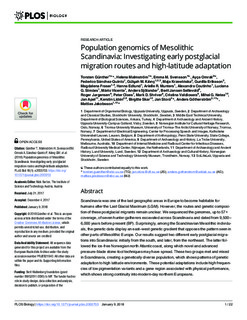| dc.contributor.author | Günther, Torsten | |
| dc.contributor.author | Malmström, Helena | |
| dc.contributor.author | Svensson, Emma M. | |
| dc.contributor.author | Omrak, Ayça | |
| dc.contributor.author | Sánchez-Quinto, Frederico | |
| dc.contributor.author | Kılınç, Gülşah M. | |
| dc.contributor.author | Krzewinska, Maja | |
| dc.contributor.author | Eriksson, Gunilla | |
| dc.contributor.author | Fraser, Magdalena | |
| dc.contributor.author | Edlund, Hanna | |
| dc.contributor.author | Munteres, Arielle R. | |
| dc.contributor.author | Coutinho, Alexandra | |
| dc.contributor.author | Simões, Luciana G. | |
| dc.contributor.author | Vicente, Mário | |
| dc.contributor.author | Sjölander, Anders | |
| dc.contributor.author | Sellevold, Berit J. | |
| dc.contributor.author | Jørgensen, Roger | |
| dc.contributor.author | Claes, Peter | |
| dc.contributor.author | Shriver, Mark D. | |
| dc.contributor.author | Valdiosera, Cristina | |
| dc.contributor.author | Netea, Mihai G. | |
| dc.contributor.author | Apel, Jan | |
| dc.contributor.author | Lidén, Kerstin Birgitta | |
| dc.contributor.author | Skar, Birgitte | |
| dc.contributor.author | Storå, Jan | |
| dc.contributor.author | Götherström, Anders | |
| dc.contributor.author | Jakobsson, Mattias | |
| dc.date.accessioned | 2018-08-13T09:05:04Z | |
| dc.date.available | 2018-08-13T09:05:04Z | |
| dc.date.created | 2018-01-12T11:02:29Z | |
| dc.date.issued | 2018 | |
| dc.identifier.issn | 1544-9173 | |
| dc.identifier.uri | http://hdl.handle.net/11250/2557645 | |
| dc.description.abstract | Scandinavia was one of the last geographic areas in Europe to become habitable for humans after the Last Glacial Maximum (LGM). However, the routes and genetic composition of these postglacial migrants remain unclear. We sequenced the genomes, up to 57× coverage, of seven hunter-gatherers excavated across Scandinavia and dated from 9,500–6,000 years before present (BP). Surprisingly, among the Scandinavian Mesolithic individuals, the genetic data display an east–west genetic gradient that opposes the pattern seen in other parts of Mesolithic Europe. Our results suggest two different early postglacial migrations into Scandinavia: initially from the south, and later, from the northeast. The latter followed the ice-free Norwegian north Atlantic coast, along which novel and advanced pressure-blade stone-tool techniques may have spread. These two groups met and mixed in Scandinavia, creating a genetically diverse population, which shows patterns of genetic adaptation to high latitude environments. These potential adaptations include high frequencies of low pigmentation variants and a gene region associated with physical performance, which shows strong continuity into modern-day northern Europeans. | nb_NO |
| dc.language.iso | eng | nb_NO |
| dc.publisher | Public Library of Science | nb_NO |
| dc.rights | Navngivelse 4.0 Internasjonal | * |
| dc.rights.uri | http://creativecommons.org/licenses/by/4.0/deed.no | * |
| dc.title | Population genomics of Mesolithic Scandinavia: Investigating early postglacial migration routes and high-latitude adaptation | nb_NO |
| dc.type | Journal article | nb_NO |
| dc.type | Peer reviewed | nb_NO |
| dc.description.version | publishedVersion | nb_NO |
| dc.source.volume | 16 | nb_NO |
| dc.source.journal | PLoS biology | nb_NO |
| dc.source.issue | 1 | nb_NO |
| dc.identifier.doi | 10.1371/journal.pbio.2003703 | |
| dc.identifier.cristin | 1541488 | |
| dc.description.localcode | © 2018 Günther et al. This is an open access article distributed under the terms of the Creative Commons Attribution License, which permits unrestricted use, distribution, and reproduction in any medium, provided the original author and source are credited. | nb_NO |
| cristin.unitcode | 194,31,5,0 | |
| cristin.unitname | Institutt for arkeologi og kulturhistorie | |
| cristin.ispublished | true | |
| cristin.fulltext | original | |
| cristin.qualitycode | 2 | |

